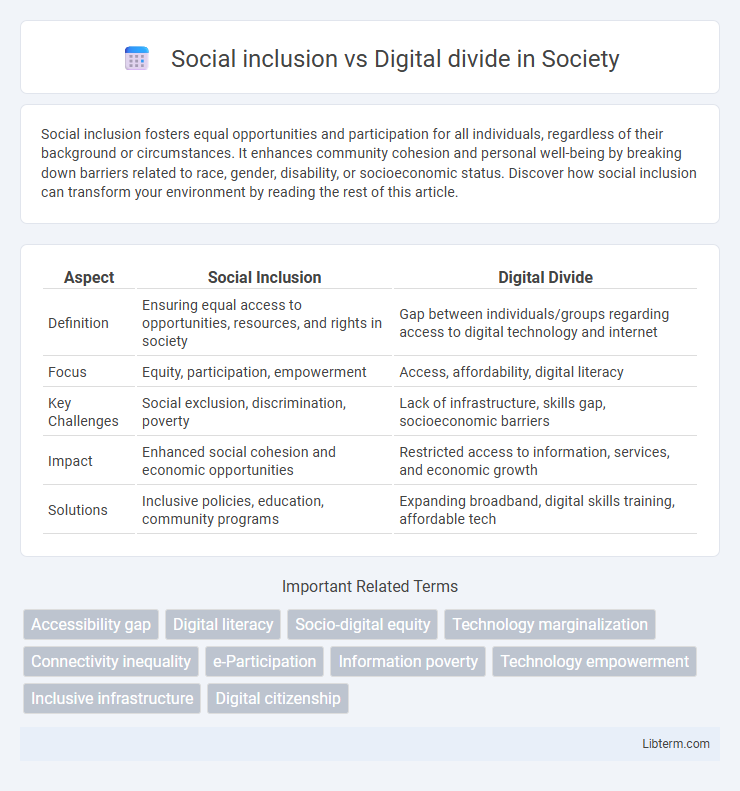Social inclusion fosters equal opportunities and participation for all individuals, regardless of their background or circumstances. It enhances community cohesion and personal well-being by breaking down barriers related to race, gender, disability, or socioeconomic status. Discover how social inclusion can transform your environment by reading the rest of this article.
Table of Comparison
| Aspect | Social Inclusion | Digital Divide |
|---|---|---|
| Definition | Ensuring equal access to opportunities, resources, and rights in society | Gap between individuals/groups regarding access to digital technology and internet |
| Focus | Equity, participation, empowerment | Access, affordability, digital literacy |
| Key Challenges | Social exclusion, discrimination, poverty | Lack of infrastructure, skills gap, socioeconomic barriers |
| Impact | Enhanced social cohesion and economic opportunities | Restricted access to information, services, and economic growth |
| Solutions | Inclusive policies, education, community programs | Expanding broadband, digital skills training, affordable tech |
Understanding Social Inclusion in the Digital Era
Social inclusion in the digital era emphasizes equitable access to technology, digital literacy, and online participation across diverse populations, ensuring marginalized groups are not left behind. The digital divide highlights disparities in internet access, device availability, and digital skills that hinder equal opportunities for education, employment, and civic engagement. Bridging this gap requires targeted policies and community initiatives to foster digital empowerment and inclusive connectivity.
Defining the Digital Divide: Scope and Impact
The digital divide refers to the gap between individuals and communities with access to modern information and communication technologies and those without, significantly influencing social inclusion. This divide encompasses disparities in internet connectivity, device availability, digital literacy, and usage, affecting education, employment, healthcare, and social participation. Bridging the digital divide is crucial to promoting equal opportunities and fostering inclusive digital societies worldwide.
The Interplay between Social Inclusion and Technology
Social inclusion hinges on equitable access to digital technologies, directly influencing opportunities for education, employment, and civic participation. Bridging the digital divide requires targeted policies that provide affordable internet, digital literacy training, and accessible devices to marginalized communities. Enhancing digital inclusion fosters social equity by empowering underserved populations to engage fully in the digital economy and society.
Barriers to Digital Access in Marginalized Communities
Marginalized communities face significant barriers to digital access, including limited infrastructure, high costs of devices and internet services, and lack of digital literacy skills. These obstacles exacerbate the digital divide, restricting opportunities for social inclusion in education, employment, and civic participation. Addressing these challenges requires targeted investments in affordable technology, community-based digital training programs, and policies promoting equitable internet access.
The Role of Education in Bridging the Digital Divide
Education plays a critical role in bridging the digital divide by equipping individuals with essential digital literacy skills and fostering equitable access to technology. Implementing inclusive educational programs ensures marginalized communities gain proficiency in using digital tools, thereby promoting social inclusion. Targeted investments in digital infrastructure and teacher training further enhance learning environments, narrowing gaps in digital access and participation.
Government Policies for Inclusive Digital Development
Government policies for inclusive digital development prioritize expanding broadband access and affordable connectivity to bridge the digital divide and promote social inclusion. Initiatives like digital literacy programs target underserved communities to enhance digital skills and ensure equitable participation in the digital economy. Regulatory frameworks support the deployment of accessible technologies and foster public-private partnerships to create inclusive digital ecosystems.
Technology as a Catalyst for Social Empowerment
Technology acts as a catalyst for social empowerment by bridging the digital divide, enabling marginalized communities to access essential resources and opportunities. Enhanced internet connectivity, affordable devices, and digital literacy programs reduce social exclusion by fostering inclusion in education, employment, and civic participation. By promoting equitable access to technological tools, societies can drive social inclusion and diminish systemic inequalities.
Case Studies: Successful Digital Inclusion Initiatives
Case studies highlight successful digital inclusion initiatives like India's Digital Saksharta Abhiyan, which empowered over 60 million individuals with digital literacy skills, bridging the digital divide in rural areas. In Kenya, the M-TIBA platform increased healthcare access by offering mobile health savings accounts, demonstrating how targeted digital tools enhance social inclusion. These examples underscore the importance of tailored interventions and community engagement in mitigating disparities caused by limited technology access.
Future Trends in Achieving Digital and Social Equity
Future trends in achieving digital and social equity emphasize expanding broadband access and affordable technology to bridge the digital divide for marginalized communities. Artificial intelligence and adaptive learning platforms are poised to personalize education and skill development, promoting social inclusion across socioeconomic backgrounds. Policymakers and tech companies increasingly collaborate to create inclusive digital infrastructures that support universal access and participation in the digital economy.
Strategies for Building a Digitally Inclusive Society
Strategies for building a digitally inclusive society focus on expanding affordable internet access, providing digital literacy training, and ensuring accessibility for diverse populations, including people with disabilities and marginalized communities. Governments and organizations implement public-private partnerships to deploy infrastructure and develop community-based programs that foster equitable technology adoption. Emphasizing inclusive policy frameworks and continuous evaluation of digital inclusion efforts addresses barriers related to socioeconomic status, geography, and education levels.
Social inclusion Infographic

 libterm.com
libterm.com